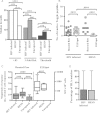Alternative effector-function profiling identifies broad HIV-specific T-cell responses in highly HIV-exposed individuals who remain uninfected
- PMID: 25249264
- PMCID: PMC4416125
- DOI: 10.1093/infdis/jiu534
Alternative effector-function profiling identifies broad HIV-specific T-cell responses in highly HIV-exposed individuals who remain uninfected
Abstract
The characterization of host immune responses to human immunodeficiency virus (HIV) in HIV controllers and individuals with high exposure but seronegativity to HIV (HESN) is needed to guide the development of effective preventive and therapeutic vaccine candidates. However, several technical hurdles severely limit the definition of an effective virus-specific T-cell response. By using a toggle-peptide approach, which takes HIV sequence diversity into account, and a novel, boosted cytokine staining/flow cytometry strategy, we here describe new patterns of T-cell responses to HIV that would be missed by standard assays. Importantly, this approach also allows detection of broad and strong virus-specific T-cell responses in HESN individuals that are characterized by a T-helper type 1 cytokine-like effector profile and produce cytokines that have been associated with potential control of HIV infection, including interleukin 10, interleukin 13, and interleukin 22. These results establish a novel approach to improve the current understanding of HIV-specific T-cell immunity and identify cellular immune responses and individual cytokines as potential markers of relative HIV resistance. As such, the findings also help develop similar strategies for more-comprehensive assessments of host immune responses to other human infections and immune-mediated disorders.
Keywords: HIV infection; T-cell responses; Th1 cytokines; Th17 cytokines; Th2 cytokines; boosted flow cytometry; highly exposed seronegative; toggled peptides.
© The Author 2014. Published by Oxford University Press on behalf of the Infectious Diseases Society of America. All rights reserved. For Permissions, please e-mail: journals.permissions@oup.com.
Figures




References
-
- Burgener A, Sainsbury J, Plummer FA, Ball TB. Systems biology-based approaches to understand HIV-exposed uninfected women. Curr HIV/AIDS Rep. 2010;7:53–9. - PubMed
-
- Goh WC, Markee J, Akridge RE, et al. Protection against human immunodeficiency virus type 1 infection in persons with repeated exposure: evidence for T cell immunity in the absence of inherited CCR5 coreceptor defects. J Infect Dis. 1999;179:548–57. - PubMed
-
- Hasselrot K, Saberg P, Hirbod T, et al. Oral HIV-exposure elicits mucosal HIV-neutralizing antibodies in uninfected men who have sex with men. AIDS. 2009;23:329–33. - PubMed
-
- Kaul R, Plummer FA, Kimani J, et al. HIV-1-specific mucosal CD8+ lymphocyte responses in the cervix of HIV-1-resistant prostitutes in Nairobi. J Immunol. 2000;164:1602–11. - PubMed
Publication types
MeSH terms
Substances
Grants and funding
LinkOut - more resources
Full Text Sources
Other Literature Sources
Research Materials

